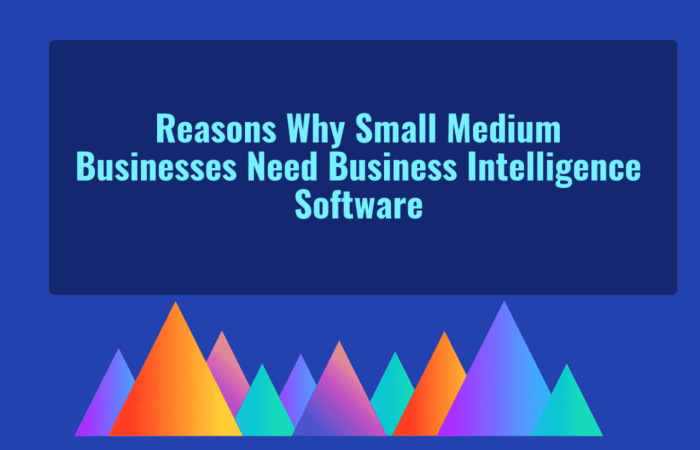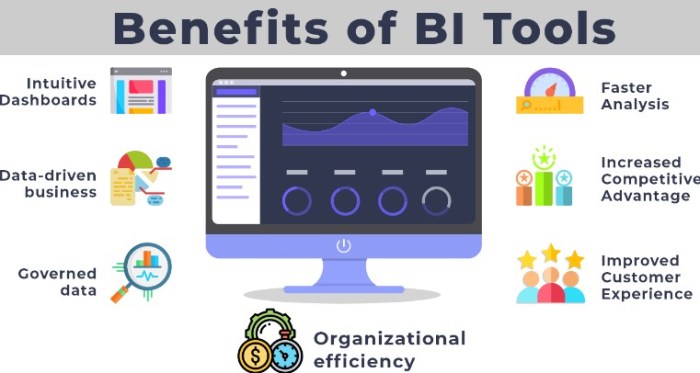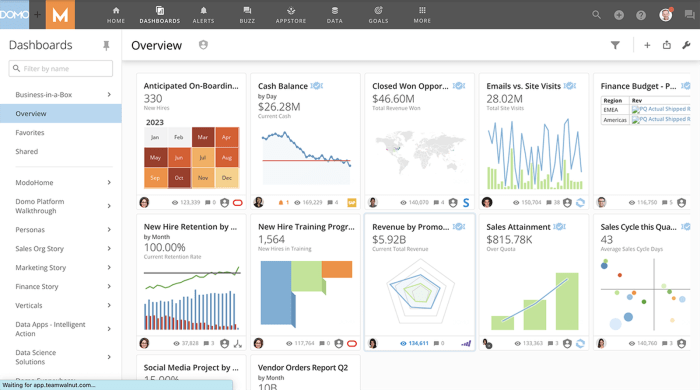Cost effective business intelligence software options for startups – Cost-effective business intelligence software options for startups are crucial for navigating the complexities of rapid growth without breaking the bank. Finding the right balance between powerful analytics and budget-friendly pricing is a challenge many early-stage companies face. This guide explores various options, from open-source alternatives to commercial solutions, helping you make an informed decision that aligns with your startup’s specific needs and financial resources.
We’ll delve into essential features, data integration strategies, and vendor selection criteria to ensure you choose a BI solution that empowers your business without draining your resources.
We’ll cover everything from understanding your budget constraints based on your funding stage (bootstrapped, seed-funded, Series A) to comparing the long-term costs of different licensing models. We’ll also examine the often-overlooked hidden costs associated with open-source options and highlight the importance of scalability and user training. By the end, you’ll have a clearer understanding of how to select a BI solution that provides significant ROI without sacrificing essential functionalities.
Defining “Cost-Effective” for Startups
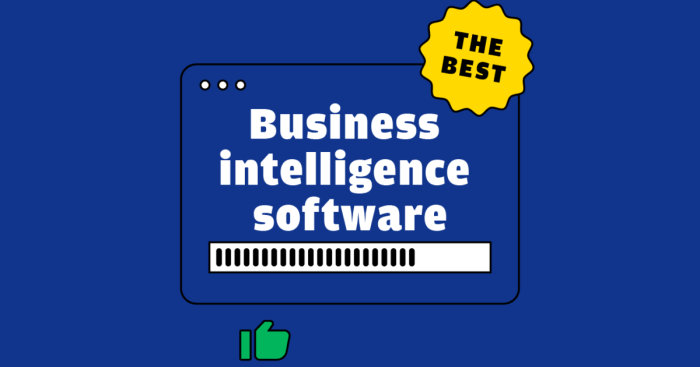
Choosing the right business intelligence (BI) software is crucial for startups, but the definition of “cost-effective” varies significantly depending on the stage of funding and overall financial picture. A solution that’s budget-friendly for a bootstrapped company might be considered insufficient for a Series A funded business with ambitious growth targets. Understanding these nuances is key to making an informed decision.Budget considerations for startup BI software are directly tied to funding.
Bootstrapped companies typically operate with extremely tight budgets, prioritizing free or very low-cost options. Seed-funded startups have more flexibility but still need to be mindful of expenses. Series A funded companies generally have a larger budget and can afford more robust, feature-rich solutions. However, even with more funding, efficient spending remains paramount.
Budget Considerations by Funding Stage
Bootstrapped startups usually need to explore free or freemium options, focusing on solutions with limited features that address their most critical needs. They might consider open-source BI tools or free tiers of popular platforms, accepting limitations in scalability and advanced analytics. Seed-funded startups can often afford entry-level paid subscriptions, balancing cost with functionality. They might opt for cloud-based solutions with scalable pricing models to adapt to their growing data needs.
Series A companies can explore more comprehensive solutions, potentially including enterprise-grade features and dedicated support, but should still compare pricing and features carefully to avoid overspending. For example, a startup using a free tool might upgrade to a paid plan as it grows, adding features like data visualization dashboards or advanced reporting as needed.
Long-Term Cost Implications of Licensing Models
The licensing model significantly impacts the long-term cost of BI software. Subscription models offer predictable monthly or annual payments, making budgeting easier. However, the total cost over several years can be substantial. Perpetual licenses involve a one-time upfront payment, seemingly cost-effective initially. However, they often require additional costs for upgrades, maintenance, and support, potentially exceeding the total cost of a subscription over the same period.
Consider a hypothetical scenario: a perpetual license costing $10,000 upfront might require $2,000 annually for maintenance and upgrades, making the three-year cost $16,000. A comparable subscription service might cost $5,000 annually, resulting in a three-year cost of $15,000. While the initial cost is higher for the subscription, the total cost over three years might be comparable or even lower.
Total Cost of Ownership (TCO) Comparison
The following table compares the TCO of three hypothetical BI software options over three years. These figures are for illustrative purposes and actual costs will vary depending on the specific software, features, and usage.
| Software Name | Annual Cost | Setup Costs | Total 3-Year Cost |
|---|---|---|---|
| SimpleBI (Subscription) | $1,000 | $500 | $3,500 |
| MidRangeBI (Subscription) | $3,000 | $1,000 | $10,000 |
| EnterpriseBI (Perpetual) | $0 (but $1,000/year for maintenance) | $8,000 | $11,000 |
Essential Features for Startup BI
Choosing the right business intelligence (BI) software is crucial for startups aiming for rapid growth. The right tools provide valuable insights, enabling data-driven decisions that can significantly impact a company’s trajectory. However, navigating the plethora of options available can be overwhelming, especially when budget constraints are a primary concern. This section focuses on identifying the core BI features essential for startups, balancing functionality with affordability.The ideal BI solution for a startup should offer a blend of powerful analytics and user-friendly accessibility.
While advanced analytical capabilities are beneficial for uncovering deep insights, the software’s ease of use is paramount, especially when considering teams with limited technical expertise. Finding the sweet spot between these two aspects is key to maximizing ROI and ensuring the software is actually used and understood by the entire team.
Essential Features for Rapid Growth
Startups require agility and speed. Their BI software needs to reflect this need. The following five features are indispensable for startups focused on rapid growth:
- Data Integration: Seamless integration with various data sources (CRM, marketing automation, sales platforms, etc.) is critical. This allows for a unified view of business performance, avoiding data silos and enabling holistic analysis. Imagine a startup using HubSpot for CRM and Google Analytics for website traffic; the BI tool should effortlessly combine this data to show the correlation between marketing campaigns and sales conversions.
- Interactive Dashboards: Customizable dashboards offering real-time visualizations of key performance indicators (KPIs) are essential for monitoring progress and identifying trends quickly. For example, a dashboard could display sales figures, customer acquisition costs, and website engagement metrics, all updated dynamically, providing an at-a-glance view of business health.
- Reporting and Export Capabilities: The ability to generate comprehensive reports and export data in various formats (PDF, CSV, Excel) is vital for sharing insights with stakeholders and integrating data into other business processes. A startup might need to generate weekly sales reports for investors or export customer data for marketing campaigns; flexible export options are crucial.
- Basic Data Analysis: While advanced analytics might not be initially necessary, basic functionalities such as filtering, sorting, and basic calculations are essential for extracting meaningful information from the data. For example, the ability to filter sales data by region or product category, or to calculate average order value, provides valuable insights for decision-making.
- Scalability: As the startup grows, its data volume will increase. The BI solution should be able to handle this growth without significant performance degradation or increased costs. Choosing a cloud-based solution usually offers better scalability compared to on-premise options.
Balancing Advanced Analytics and Ease of Use
Advanced analytics, such as predictive modeling and machine learning, offer the potential for significant insights. However, these capabilities often require specialized skills and can be more complex to implement and interpret. For startups, prioritizing ease of use for non-technical users is often more crucial initially. A user-friendly interface empowers all team members to access and understand the data, fostering a data-driven culture across the organization.
The focus should be on providing actionable insights in a clear and concise manner, rather than overwhelming users with overly complex analytical models. For example, a simple visualization showing the correlation between marketing spend and customer acquisition cost is more valuable to a non-technical user than a complex predictive model forecasting future sales.
Features That Can Be Sacrificed Initially
To reduce costs without significantly compromising business decision-making, certain features can be deferred.
- Advanced Predictive Modeling: Sophisticated predictive analytics can be implemented later as the startup matures and has more data to work with.
- Custom Integrations: Focus on readily available integrations with commonly used tools. Custom integrations can be explored later as needed.
- Extensive Data Visualization Options: While basic visualizations are essential, a wide array of highly specialized charts and graphs can be postponed.
- Complex Data Warehousing: Start with a simpler data structure and move to more complex warehousing solutions as data volume and complexity grow.
- Real-time Data Processing for all data sources: Prioritize real-time data for critical KPIs, delaying real-time processing for less crucial data sources.
Open-Source vs. Commercial Options
Choosing between open-source and commercial Business Intelligence (BI) software is a crucial decision for startups, impacting both budget and long-term scalability. Both options offer distinct advantages and disadvantages, and the best choice depends heavily on the startup’s specific needs, technical expertise, and risk tolerance. Understanding these nuances is key to making an informed decision.Open-source BI tools, like their commercial counterparts, provide a suite of functionalities for data analysis and visualization.
However, the nature of their development, licensing, and support drastically differs. Commercial solutions offer a polished user experience, comprehensive support, and regular updates, often bundled with robust security features. Open-source options, on the other hand, prioritize flexibility and community-driven development but require a higher level of technical expertise for implementation and maintenance.
Hidden Costs of Open-Source BI Software
While the initial cost of open-source BI software is zero, several hidden expenses can quickly accumulate. Implementation, for instance, often requires specialized skills and can necessitate hiring consultants or dedicated developers, significantly increasing the overall cost. Ongoing maintenance and updates also demand resources. Without dedicated support channels, resolving bugs or integrating with other systems can become time-consuming and expensive.
Furthermore, security vulnerabilities in open-source software, if not properly addressed, can lead to data breaches and substantial financial losses, adding unexpected costs for remediation and damage control. For example, a startup might initially save on software licensing, but then spend a considerable sum on hiring a developer to customize the open-source tool to integrate with their existing CRM system, a cost that’s easily overlooked.
Comparison of Open-Source and Commercial BI Tools
The following table compares key features, pricing, and support levels of two popular open-source and two commercial BI tools. Note that features and pricing can change over time, so always verify the latest information on the vendor’s website.
| Feature | Open-Source Tool A (e.g., Metabase) | Open-Source Tool B (e.g., Redash) | Commercial Tool A (e.g., Tableau) | Commercial Tool B (e.g., Power BI) |
|---|---|---|---|---|
| Data Connectivity | SQL databases, CSV, etc. (varies depending on specific setup) | Variety of databases and APIs, requires configuration | Wide range of databases and cloud services, easy integration | Extensive database and cloud service connectivity, user-friendly integration |
| Visualization Capabilities | Basic charts and dashboards, customization requires coding | Customizable dashboards and visualizations, requires technical knowledge | Highly advanced visualizations, drag-and-drop interface | Rich visualizations, intuitive interface, interactive dashboards |
| Reporting & Dashboards | Customizable reports, requires technical skills for complex reports | Supports complex report creation, needs technical expertise for advanced features | Pre-built templates and custom report creation, user-friendly interface | Interactive dashboards, report scheduling, and distribution features |
| Pricing Model | Free (but may incur costs for implementation, maintenance, and support) | Free (but may incur costs for implementation, maintenance, and support) | Subscription-based, varying tiers with different feature sets | Subscription-based, various plans catering to different user needs |
| Support Level | Community support forums, limited professional support | Community support forums, limited professional support | Dedicated support team, comprehensive documentation, training resources | Dedicated support team, extensive documentation, training materials |
Data Integration and Scalability

Choosing the right business intelligence (BI) software for a startup hinges on more than just price; it’s about finding a solution that can seamlessly handle your current data needs and effortlessly scale to accommodate future growth. Data integration complexity and scalability are intertwined factors that significantly influence the long-term cost and effectiveness of your BI strategy. Ignoring these aspects can lead to costly migrations, data silos, and ultimately, hindered business insights.The complexity of integrating various data sources directly impacts the overall cost of a BI solution.
A simple, unified data structure requires less effort and expertise to integrate, leading to lower initial setup costs and reduced ongoing maintenance. Conversely, a fragmented data landscape, with disparate systems and inconsistent formats, necessitates more complex ETL (Extract, Transform, Load) processes, demanding specialized skills and potentially expensive third-party integration tools. This complexity translates into higher initial investment, increased ongoing maintenance expenses, and potentially delayed time-to-insight.
The more time and resources spent wrestling with data integration, the less time is available for actually using the BI software to make strategic decisions.
Data Integration Complexity and Cost, Cost effective business intelligence software options for startups
The cost of data integration isn’t just about the software itself; it’s also about the human resources required. For startups with limited internal IT capabilities, outsourcing data integration can significantly increase costs. Furthermore, poorly integrated data can lead to inaccurate reporting and flawed business decisions, which can have far-reaching and expensive consequences. A well-structured, streamlined data integration process is, therefore, a crucial investment in the long-term success of any BI initiative.
Consider the cost of correcting errors stemming from poor data integration – it can easily outweigh the initial investment in a robust, well-planned solution. For example, a startup relying on manual data entry from multiple spreadsheets will inevitably encounter inconsistencies and errors, leading to costly rework and potentially missed opportunities.
Scalability in Startup BI
Scalability is paramount for startups experiencing rapid growth. Choosing a BI solution that can handle increasing data volumes and user demands without significant performance degradation or costly upgrades is essential. A scalable solution allows for smooth expansion without requiring a complete system overhaul as the company grows. This avoids disrupting workflows and preserves the valuable insights the BI tool provides.
For instance, a startup initially using a simple spreadsheet for data analysis will quickly outgrow this method as its customer base and product lines expand. Transitioning to a scalable BI solution allows for seamless integration of new data sources and user access, ensuring continued data-driven decision-making throughout the growth phase.
Common Startup Data Sources and Integration Strategies
Startups typically utilize a variety of data sources, including CRM systems (Salesforce, HubSpot), marketing automation platforms (Marketo, Mailchimp), e-commerce platforms (Shopify, WooCommerce), and internal databases (MySQL, PostgreSQL). Efficient and cost-effective integration often involves utilizing APIs (Application Programming Interfaces) offered by these platforms. APIs allow for automated data extraction and transfer, minimizing manual effort and reducing the risk of errors.
Many BI tools offer pre-built connectors for popular platforms, simplifying the integration process. For example, a startup using Salesforce for CRM and Shopify for e-commerce can leverage pre-built connectors to seamlessly integrate customer data, sales figures, and marketing campaign results within their BI platform, providing a holistic view of their business performance. Using these pre-built connectors is generally more cost-effective than developing custom integration solutions.
User Training and Support: Cost Effective Business Intelligence Software Options For Startups
Choosing the right business intelligence (BI) software is only half the battle for startups. Effective implementation hinges on user adoption, and that requires adequate training and ongoing support. The cost of these factors can significantly impact your overall BI investment, making careful consideration crucial. Ignoring this aspect can lead to underutilized software and a poor return on investment.The cost implications of user training and support vary dramatically depending on the software vendor and the chosen support plan.
Open-source options typically offer limited or no formal training, relying instead on community forums and online documentation. This translates to a lower upfront cost but potentially higher long-term costs in terms of employee time spent learning the software and troubleshooting issues. Commercial vendors, on the other hand, often provide comprehensive training packages—ranging from online tutorials to in-person workshops—and dedicated support channels, but at a price.
This cost can be substantial, especially for startups with limited budgets. A hybrid approach, leveraging free online resources and supplementing with targeted training for key personnel, may represent the optimal balance for many startups.
Examine how best business intelligence tools for small businesses can boost performance in your area.
Cost-Benefit Analysis of User Training
A cost-benefit analysis (CBA) is a valuable tool for justifying the investment in user training. It involves comparing the costs of training against the anticipated benefits. For example, a startup might consider the cost of a vendor-provided training course, the cost of employee time spent attending the course, and any travel expenses. On the benefit side, the CBA would quantify improvements in data analysis efficiency, faster report generation, better decision-making, and potentially increased revenue or cost savings resulting from improved insights.
A simple CBA formula could be:
Net Benefit = (Increased Revenue + Cost Savings)
(Training Costs + Employee Time Costs)
For instance, if a training course costs $2,000 and saves the company $5,000 annually in improved efficiency, the net benefit in the first year is $3,000. This positive net benefit demonstrates the value of the investment. However, the analysis should also consider the long-term impact. Will the training improve efficiency for years to come, justifying the initial investment?
This type of analysis needs to be tailored to the specific needs and circumstances of each startup.
Resources for Reducing Reliance on Paid Support
Startups can significantly reduce their reliance on paid support by proactively utilizing various free resources. Many BI software vendors offer comprehensive online documentation, including tutorials, FAQs, and user manuals. These resources often provide step-by-step instructions and troubleshooting guides, addressing many common user issues. Furthermore, active online communities and forums dedicated to specific BI software can be invaluable sources of information and peer support.
Users can often find solutions to their problems by searching existing threads or posting questions to the community. Utilizing these free resources can significantly reduce the need for costly paid support, freeing up budget for other critical startup needs.
Choosing the Right BI Vendor
Selecting the perfect business intelligence (BI) vendor for your startup isn’t just about finding the cheapest option; it’s about finding a long-term partner that can grow with your business. A poorly chosen vendor can lead to wasted resources, integration headaches, and ultimately, hinder your data-driven decision-making. Therefore, a strategic approach is crucial.Evaluating different BI vendors requires a multifaceted approach, going beyond simple price comparisons.
Factors like vendor reputation, customer support responsiveness, ease of integration with existing systems, and the vendor’s long-term financial stability are all critical considerations. A cheap solution that lacks support or fails to integrate effectively can prove far more costly in the long run than a slightly more expensive, robust option.
Vendor Evaluation Criteria Beyond Price
Several key factors should guide your evaluation of potential BI vendors. These extend beyond the initial cost, focusing on the overall value and long-term partnership. Consider the vendor’s track record with startups, their expertise in your industry, the scalability of their platform, and the level of customization offered. A vendor with a proven history of success with companies similar to yours, coupled with adaptable technology, is a significant advantage.
Furthermore, scrutinize their customer support mechanisms – availability, responsiveness, and the expertise of their support team. A responsive and knowledgeable support team can be invaluable when you encounter technical issues or require assistance with data analysis. Finally, investigate the vendor’s financial stability and market presence to ensure a long-term, reliable partnership. Choosing a vendor on the brink of collapse could leave your business stranded with an unsupported system.
Decision-Making Framework for BI Software Selection
To streamline the selection process, a structured framework can prove incredibly beneficial. Begin by clearly defining your startup’s specific BI needs and goals. What data do you need to analyze? What insights are you hoping to gain? What are your current technological limitations?
Next, establish a realistic budget, considering both the initial investment and ongoing costs (maintenance, support, potential upgrades). Then, create a shortlist of potential vendors that meet your initial criteria, focusing on those aligning with your budget and technological needs. Subsequently, conduct a thorough evaluation of each shortlisted vendor using the criteria Artikeld above (customer support, integration capabilities, long-term viability, etc.).
Finally, compare the vendors side-by-side, weighing the pros and cons of each option against your prioritized needs and budget constraints. This methodical approach helps eliminate subjectivity and ensures a data-driven decision, mirroring the very principle of business intelligence. For example, a startup focusing on e-commerce might prioritize a vendor with robust e-commerce data integration capabilities, while a SaaS startup might focus on user behavior analytics integration.
Checklist of Questions for Potential BI Vendors
Before committing to a purchase, it’s crucial to engage in thorough due diligence. This involves directly questioning potential vendors to validate their claims and assess their suitability. Ask about their experience working with startups of similar size and industry. Inquire about their data security measures and compliance certifications. Clarify their integration capabilities with your existing systems (CRM, ERP, marketing automation platforms).
Explore the details of their customer support offerings – response times, available channels (phone, email, chat), and service level agreements (SLAs). Investigate their pricing model – is it subscription-based? What are the hidden costs? What are the options for scaling the solution as your business grows? Finally, request case studies or references from existing clients to gain independent insights into their performance and customer satisfaction.
A comprehensive list of questions ensures you’re making an informed decision that aligns with your long-term business objectives.
Illustrative Examples of Cost-Effective BI Implementations
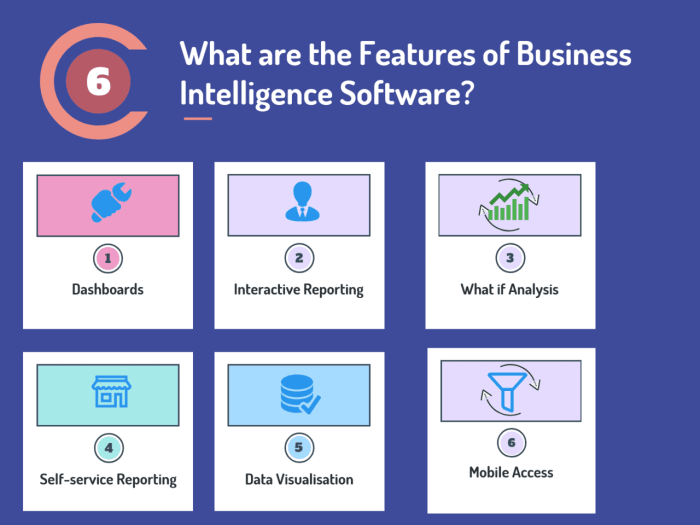
Choosing the right BI solution is crucial for startups, and seeing real-world examples of successful implementations can provide invaluable insights. Understanding how other businesses leveraged cost-effective strategies can help you navigate your own BI journey. The following case studies showcase how startups effectively used affordable BI tools to achieve significant business improvements.
Case Study 1: E-commerce Startup “TrendyThreads” Utilizing Google Data Studio
TrendyThreads, a rapidly growing online clothing retailer, initially struggled with analyzing their vast sales data spread across various platforms like Shopify and Google Analytics. Their marketing spend was significant, but they lacked a clear understanding of ROI across different campaigns. They chose Google Data Studio, a free BI tool, to consolidate their data. This decision was driven by their need for a cost-effective solution that could scale with their growth.They integrated data from Shopify (sales, customer demographics, product performance), Google Analytics (website traffic, user behavior), and Google Ads (campaign performance).
By creating interactive dashboards in Data Studio, TrendyThreads gained a comprehensive view of their sales performance, customer segmentation, and marketing campaign effectiveness. This allowed them to identify top-performing products, optimize marketing campaigns based on real-time data, and personalize customer experiences. The result? A 15% increase in sales conversion rates within six months and a 10% reduction in marketing costs.
They overcame initial challenges related to data cleaning and standardization by dedicating a small team to data preparation before importing it into Data Studio. The team also utilized readily available online resources and tutorials to quickly master the platform’s functionalities.
Case Study 2: Food Delivery Startup “QuickBite” Leveraging Metabase
QuickBite, a food delivery startup focusing on local restaurants, needed a way to track order volume, delivery times, customer satisfaction, and driver performance. Their initial reliance on spreadsheets proved cumbersome and inefficient. They opted for Metabase, an open-source BI tool, primarily due to its cost-effectiveness and ease of use. The open-source nature allowed their technical team to customize the platform according to their specific needs.Data integration involved connecting Metabase to their order management system, customer relationship management (CRM) system, and driver tracking application.
This allowed them to create dashboards that provided real-time insights into key performance indicators (KPIs) like average order value, delivery times, customer ratings, and driver efficiency. By analyzing this data, QuickBite identified bottlenecks in their delivery process, optimized driver routes, and improved customer service responsiveness. This led to a 20% reduction in average delivery times and a 10% increase in customer satisfaction ratings.
A key challenge was the initial learning curve associated with Metabase’s customization capabilities. However, QuickBite addressed this by assigning a dedicated developer to initially configure the system and provide ongoing training to other team members.
